 |
 |
 |
 |
 |
 |
 |
|
|
 |
|
|
 |
|
Non-flat tilings with flat tiles
Abstract
In general a tiling is considered to be a set of tiles placed next to each other in a flat plane. The tiles are placed in the plane in such a way that there are no gaps and no overlaps. But what if we leave out the condition that the plane has to be flat? For when there are no gaps and no overlaps between the tiles we still can call it a tiling. We will discuss the consequences for the possible shapes of the tiles in non-flat tilings as well as the possible symmetrical structures that can be used.
1. Tilings
1.1. Definition. A tiling, or tessellation, is a covering of a plane surface without gaps or overlaps by polygons, all of which are the same size and shape. That is one of the definitions of a tiling. Another definition is the following: Tiling: a pattern made of identical shapes; the shapes must fit together without any gaps and the shapes should not overlap. Although the second definition doesn’t speak about a plane, it is mostly assumed that the tiles do cover a plane. But we can take this definition literally, and then the only conditions are that the tiles do not overlap and do not leave gaps. Tilings in which all the tiles have the same shape are usually called monohedral tilings [1]. In this paper all the tilings will be monohedral. In the example of Figure 1 we see a set of identical L-shaped tiles. With these tiles we can make a tiling that is a covering of a plane. And there are several ways to do this.
|
|
|
|
 |
|
|
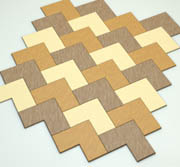 |
|
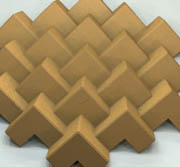 |
|
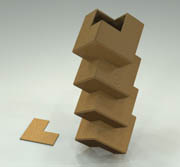 |
|
|
|
Figure 1: L-shaped tiles.
|
Figure 2: A non-flat tiling.
|
Figure 3: Cylindrical tiling
|
|
| 1.2. Non-flat tilings. Besides the possibility shown in Figure 1, where the tiles are put together in such a way that they cover a flat plane, there are a few more ways to put the tiles together under the condition that there are no overlaps or gaps in the construction. In Figure 2 the L-shaped tiles are set up in such a way that we can make a three dimensional construction. As you can see, the structure is made out of identical shapes. The tiles do not overlap and there are no gaps in the structure. To call it a tiling in the traditional way, the only remark one can have is that it is not a covering of a flat plane. But it still is a tiling. Also when we combine the tiles in the way shown in Figure 3, the resulting structure is a tiling. |
|
| 1.3. Squares. There are more shapes that can be used to create non-flat tilings and some of them are well known. The flat tiling of the plane by squares is well known, but we can also make non-flat tilings using the squares (Figure 4), again there are no overlaps and no gaps in the structure. The most well known way to combine the squares in a three-dimensional way is the cube (Figure 5), although usually we do not call this a tiling |
|
 |
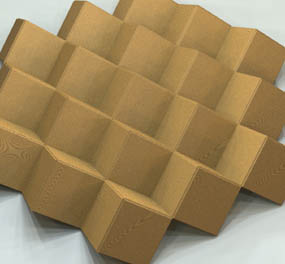 |
|
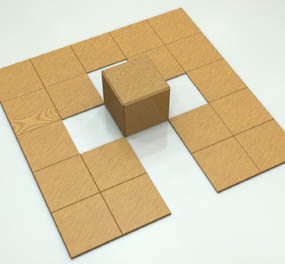 |
|
|
|
|
Figure 4: Non-flat tiling with square tiles.
|
Figure 5: Non-flat tiling: the cube.
|
|
| 1.4. Polyhedra. Just as with the cube, the other Platonic solids can be interpreted as non-flat tilings (Figure 6). In fact the standard term for “non-flat tiling” is “polyhedron”. And because all the tilings in this paper are monohedral we can call these tilings “monohedra”. So for non-flat tilings, the regular pentagon can be used as a tile, which is not possible in the plane. |
|
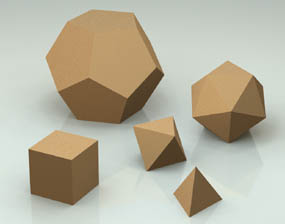 |
|
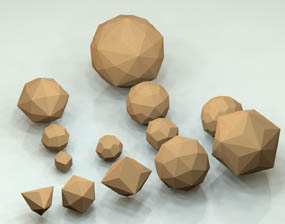 |
|
|
|
Figure 6: Platonic solids
|
Figure 7: Duals of the Archimedean solids
|
|
| 1.5. Duals of the Archimedean Solids. The Archimedean solids all have two or more different faces, or tiles. For a monohedral tiling the pattern has to be made with identical shapes, so therefore the Archimedean solids cannot be seen as monohedral tilings. But when we look at the dual of an Archimedean solid then we see that such an object is built with all identical shapes. Figure 7 shows the complete collection of the thirteen duals. Seven of them are built with triangle-shape tiles, in four duals you will find quadrangle tiles and in two cases pentagonal tiles are used. And because each dual is made out of identical shapes, they can be seen as non-flat tilings. |
|
 |
|
|
|
|
|
|
|
|
|
|
|
|
|
|
|
|
|
|







